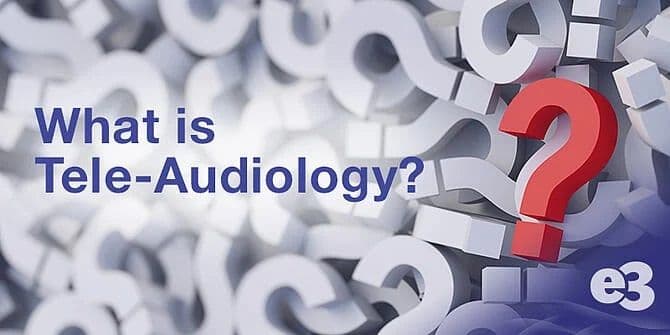What is Tele-Audiology?

Many people don’t have the time to see their health care providers. It’s a sad, but true, fact of life. The constraints of career and family obligations make it difficult for many to find time to see their primary care physicians, let alone specialists such as audiologists.
And then there are those who lack access to care, such as people living in rural communities. When the nearest audiology practice is an hour drive away, it’s difficult to find the motivation to seek treatment.
However, today’s technology makes it possible for patients to seek a hearing screening or hearing aid consultation without even leaving their homes. Thanks to tele-audiology, they can receive the care they need no matter what prevents them from making an office visit.
Tele-Audiology Explained
Simply put, tele-audiology is the remote delivery of audiology services. The audiologist and their patient don’t meet in a traditional medical office setting. Rather, the interaction occurs using a virtual communications platform. It can be as simple as offering virtual audiology screenings on a website or more in-depth hearing screenings that require tele-audiology machines that provide quality indicators to clinicians.
Tele-audiology may also encompass “meetings” between an audiologist and patient. Called “synchronous” events, these happen in real time. Think of this in terms of a Zoom meeting or Skype conversation. However, neither of those platforms could be used because of HIPAA regulations. Rather, you need a video conferencing system that can provide complete encryption of patients’ personal data.
Asynchronous events occur when the clinician and patient aren’t communicating at the same time. This could occur via an email conversation, online chat or other means of communication.Hybrid tele-audiology models also exist. For example, a patient might take an online hearing test in preparation for an upcomingtele-session.
Ways audiologists can incorporate tele-audiology into their practice include:
- Virtual diagnostic screenings and testing
- Hearing aid fittings, orientation and troubleshooting
- 3D video otoscopy
- Tympanometry, auditory brainstem testing and OAE testing
- Aftercare hearingaid services, including hearing aid programming if apps or videos make this possible
- Virtual assessment of balance disorders
- Home-based aural rehabilitation
- Tinnitus evaluation and management
- Remote programming of cochlear implants
Challenges of Tele-Audiology
The VA launched a pilot program in 2009 that offered some remote audiology services to patients who lived in areas where audiology services weren’t available. During the pilot program, 1,170 patients received virtual audiology services and the VA reported the outcomes were “as good or better than traditional face-to-face encounters.”
However, potential barriers to tele-audiology exist. For instance, the lack of a high-speed or stable Internet connection — on the part of the clinician or patient — could make it difficult to offer services.
User-error or difficulty with video conferencing software or mobile apps also poses a challenge. False negatives due to environmental variables, an inability of patients to understand test results, and an overall preference for face-to-face encounters could further make tele-audiology challenging for today’s practitioners.
Benefits of Tele-Audiology
Even with these potential drawbacks, virtual audiology is vital for audiologists to adopt. Consider these key benefits:
- It is cost-effective.Tele-audiology reduces the cost of care while increasing efficiency. Improved patient management, shared clinic practitioners and decreased travel expenses factor into the equation.
- It is necessary. A nationwide shortage of audiologists means America’s aging population may not have access to the care they need otherwise. Increase tele-health services help to bridge the divide and connect people with professionals despite their locations.
- Patients prefer it. Often, patients can get care quicker and more conveniently by using remote services instead of in-person appointments.
Tele-Audiology Machines
The options for implementing a tele-audiology program are extensive. Clinicians should carefully research the benefits of the technology they are considering to support a tele-health program.
Does the patient-directed evaluation tool use patented test methods and accuracy algorithms to conduct diagnostic and screening audiometry? Consider the GSI AMTAS Flex™ tool from e3 Diagnostics.
Along with the technical capabilities, audiologists should weigh the availability of technical support before deciding on a specific product.
For example, does the company provide 24-hour response times if something goes wrong with the technology that can test for air and bone conduction with masking and speech SRT?Whatever technology you select, make sure it’s validated, accurate and focused on patient care.The GSI AMTAS Pro™ tool is an excellent option.
e3 Diagnostics offers multiple reliable solutions to support a tele-audiology platform. To learn more about the products featured above, and how they can support patients,get in touch today.
References
https://www.grason-stadler.com/teleaudiology
https://idainstitute.com/tools/university_course/module_5/tele_audiology_and_person_centered_care/
https://www.hearingreview.com/practice-building/office-services/telehealth/critical-steps-establishing-teleaudiology-practice
https://journals.lww.com/thehearingjournal/fulltext/2019/01000/risks,_rewards_of_teleaudiology.1.aspx
